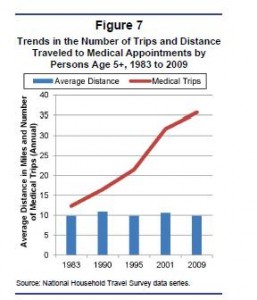
For decades, the transportation preferences of baby boomers have shaped transportation policy in the U.S. As this generation ages, the once automobile dependent segment of the population is faced with a new mobility challenge throughout the country: how to get around when driving is no longer the best option. A new study by the AARP Public Policy Institute is examining data trends to help address this challenge.
Looking at the 2009 National Household Travel Survey as well as surveys from 1977, 1983, 1990, 1995 and 2001, AARP finds interesting trends in travel patterns including:
- Declining vehicle miles traveled for all populations, even the boomer population, which has “traditionally traveled more than their counterparts in other age groups”;
- As the boomer population ages, the per capita number of boomer transit trips it takes has increased;
- Travel to medical services has significantly increased and is expected to continue to increase. The report notes that “while the distance traveled [. . .] has remained about the same for the past three decades, the number of medical trips has skyrocketed.”
The report offers policy recommendations focused on improving and maintaining mobility for this age group including:
- Coordination within the health care industry to reduce patients’ number of vehicle trips;
- Adopting individual “personal mobility planning” – planning for a time when owning and operating a personal vehicle is no longer an option; and
- Promoting transit-oriented developments which connect public transportation and a mix of building uses. TOD “could enable older residents to remain in their communities, perhaps in smaller homes, and increase their access to transit and other community services.”
The study notes, “Just as boomers changed the country’s travel patterns over the past 40 years, they will influence the broad range of senior transportation strategies employed to address the travel needs of older adults today and tomorrow.”
While AARP’s report recommendations will hopefully influence a national conversation on how to promote a more multi-modal transportation network; the group’s regional chapters have been very active on increasing mobility options for seniors. AARP NY advocated vigorously for New York State’s Complete Streets law, which was passed in 2011. This past September, the group organized a New York Complete Streets Week. Last summer, AARP NJ advocates joined hundreds of residents, nationally known pedestrian safety expert Dan Burden, and elected officials to draw attention to the deadly Black Horse Pike in southern New Jersey’s Atlantic County. The group also worked to garner support from Congressman Frank LoBiondo (R-NJ) for federal Complete Streets legislation.
Though AARP terms these and other recommendations “senior transportation strategies,” these strategies also benefit the broader populace. Housing developers are finding that TOD is attractive to a wide demographic beyond seniors. New technology also plays a role: investments like real-time bus information are appealing to both the younger, tech-savvy generations and seniors who may enticed out of their vehicles because of more accurate bus arrival information.
AARP’s continued advocacy for safer streets and more complete communities will not only benefit their members, but pedestrians, bicyclists and drivers of all ages.
